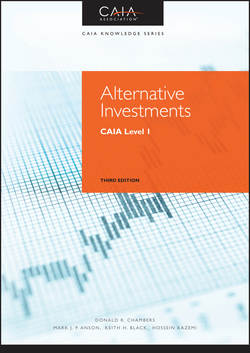Читать книгу Alternative Investments - Hossein Kazemi - Страница 11
На сайте Литреса книга снята с продажи.
PART One
Introduction to Alternative Investments
CHAPTER 1
What Is an Alternative Investment?
1.2 Alternative Investments by Inclusion
1.2.1 Real Assets
ОглавлениеReal assets are investments in which the underlying assets involve direct ownership of nonfinancial assets rather than ownership through financial assets, such as the securities of manufacturing or service enterprises. Real assets tend to represent more direct claims on consumption than do common stocks, and they tend to do so with less reliance on factors that create value in a company, such as intangible assets and managerial skill. So while a corporation such as Google holds real estate and other real assets, the value to its common stock is highly reliant on perceptions of the ability of the firm's management to oversee creation and sales of its goods and services.
An aspect that distinguishes types of real assets is the extent to which the ownership of the real assets involves operational aspects, such as day-to-day management decisions that have substantial impacts on the performance of the assets. For example, in many instances, direct ownership of oil reserves or stockpiles of copper involve substantially less day-to-day managerial attention than does direct ownership of real estate, infrastructure, or intellectual property.
Natural resources focus on direct ownership of real assets that have received little or no alteration by humans, such as mineral and energy rights or reserves. Commodities are differentiated from natural resources by their emphasis on having been extracted or produced. Commodities are homogeneous goods available in large quantities, such as energy products, agricultural products, metals, and building materials. Most of the investments covered in the commodities section of the CAIA curriculum involve futures contracts, so understanding futures contracts is an important part of understanding commodities. Futures contracts are regulated distinctly and have well-defined economic properties. For example, the analysis of futures contracts typically emphasizes notional amounts rather than the amount of money posted as collateral or margin to acquire positions.
Commodities as an investment class refer to investment products with somewhat passive (i.e., buy-and-hold) exposure to commodity prices. This exposure can be obtained through futures contracts, physical commodities, natural resource companies, and exchange-traded funds. Actively traded futures contracts on commodities are discussed in Part 3 on hedge funds and managed futures.
Some real assets are operationally focused. For the purposes of the CAIA curriculum, operationally focused real assets include real estate, land, infrastructure, and intellectual property. The performance of these types of real assets is substantially affected by the skill and success of regular and relatively frequent managerial decision-making. Traditional common stocks are typically even more highly operationally focused.
Real estate focuses on land and improvements that are permanently affixed, like buildings. Real estate was a significant asset class long before stocks and bonds became important. Prior to the industrial age, land was the single most valuable asset class. Only a few decades ago, real estate was the most valuable asset of most individuals, because ownership of a primary residence was more common than ownership of financial investments.
Land comprises a variety of forms, including undeveloped land, timberland, and farmland. Although undeveloped land might appear to belong under the category of natural resources rather than operationally focused real assets, the option to develop land often requires substantial and ongoing managerial decision-making. Timberland includes both the land and the timber of forests of tree species typically used in the forest products industry. While the underlying land is a natural resource, timberland requires some level of ongoing management. Finally, farmland consists of land cultivated for row crops (e.g., vegetables and grains) and permanent crops (e.g., orchards and vineyards). Farmland necessitates substantial operations and managerial decisions.
Infrastructure investments are claims on the income of toll roads, regulated utilities, ports, airports, and other real assets that are traditionally held and controlled by the public sector (i.e., various levels of government). Investable infrastructure opportunities include securities generated by the privatization of existing infrastructure or by the private creation of new infrastructure via private financing.
Finally, while some descriptions of real assets limit the category to tangible assets, we define real assets to include intangible assets, such as intellectual property (e.g., patents, copyrights, and trademarks, as well as music, film, and publishing royalties). The opposite of a real asset is a financial asset, not an intangible asset. A financial asset is not a real asset – it is a claim on cash flows, such as a share of stock or a bond. Intangible assets, such as technology, directly facilitate production, thereby creating increased value. It can be argued that intangible assets represent a very large and rapidly increasing role in the wealth of society.
